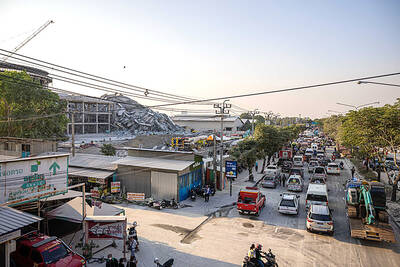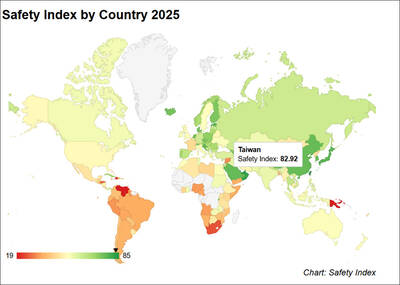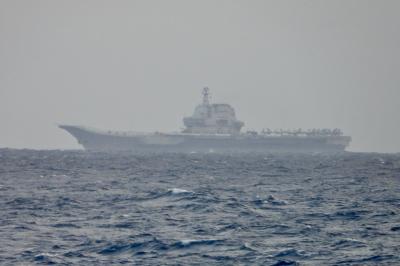For the Taiwanese, Matsu -- goddess of the sea and queen of heaven -- is a deity many know about but few have actually seen face-to-face.
The same could be said of the Matsu islands north of Taiwan that were originally named for the goddess. When you actually do see them for yourself, you find they are more beautiful than you could have imagined and almost completely unlike anything you have seen before. Today's Matsu is a mosaic of military history overlaid on a maritime culture, carved out of solid granite cliffs.
We were in Matsu for a tour that would include Dongyin, Beigan and Nangan.
Dongyin Lighthouse
The Dongyin Lighthouse sits on the northeast side of Dongyin, perched atop a rocky mountain at the end of a peninsula facing the Taiwan Strait. It is perhaps the most famous of all the lighthouses in Taiwan, and the one that appears on all the postcards of Matsu.
The best photos are taken on a sunny day against a background of blue sky and aquamarine ocean that perfectly offsets the stark white gown of this "Maiden of the Mist".
But it is only on a less-than-perfect day -- when the island lies half-shrouded in fog -- that you can understand why the British built this lighthouse to guide ships on their way to China. It also explains the cannons that lies about 50m down the cliff from the lighthouse. These cannons did not ward off Japanese pirates or Chinese invaders. They were fog cannon to warn ships about the treacherous rocks below the cliffs.
Thread of Sky
Across the bay from the Dongyin Lighthouse is a unique place where the waves have carved out a cleft in the rock. The cleft forms a narrow passageway, with steep granite walls that rise straight to the sky. As you look up from near the bottom of this crevice, you can see only a thin, blue ribbon of sky. This is why the soldiers who dug in here called this place Yihsiantian or "Thread of Sky."
Another feature of this place, which remains an important military outpost, is the sound of crashing waves echoing against the walls. They say that when you hear the echoing waves here, you can imagine the sound of a thousand horses galloping through the crevice.
Andong Tunnel
The mountains of Matsu are hollow. Every one of them has been excavated to provide fortifications and shelters for Taiwan's military. On Dongyin, the most famous of these excavations is the Andong Tunnel, which was once home to 1,000 troops.
The underground fortress consists of one main tunnel that branches out into five smaller tunnels, each ending at an opening in the sea cliffs that offers a commanding view of the strait. Once upon a time, these outlooks were used to keep an eye out for enemy ships or enemy frogmen trying to sneak up on the shore. Today, they offer five great vantage points for looking out across the blue-green waters of the bay.
The tunnel leading to the sleeping quarters for the troops offers a view of a different kind: a look at the lives of the men who called this place home. Painted on the walls of the tunnel -- in large red characters -- are slogans that were meant to inspire the men in their fight against the communist hordes. Roughly translated, the inscriptions encourage the soldiers to "Be Strong" "Be Quiet", "Persevere", "Be Brave"' and "Be Solemn".
Qingbi Village
The old village of Qingbi represents the most traditional village in Beigan. If you rise early and go to Qingbi, you can watch the sun rise over the ocean. Like most of Matsu's villages, it's situated by a coastal inlet with houses facing out to sea and backing onto the hillside. As the morning sun climbs over the horizon, the village is still and peaceful. The dawn's early light casts long shadows from the stone-walled buildings.
Qingbi by dawn is as pretty as a picture, but unnaturally quiet. Most of the former villagers have moved away and sometimes it feels like a ghost town.
According to local history, houses were well made because many pirates used to live in Qingbi, making it one of Matsu's wealthiest spots. There is rumor that a pirate's treasure is still buried under one of the buildings. However, the cellar has now been filled in and no one knows for sure if the story is true. It's one of the enduring mysteries of Qingbi.
Tangchi Village
The pristine waters off Matsu provide abundant fishing grounds, making them a paradise for sportsmen and the lifeblood of Matsu. Of the many fish products from Matsu, perhaps the best known are fish noodles and fish balls. And Tangchi has the reputation for having the best.
Fish noodles and fish balls here are made from high-grade fish and have a have a very high fish-to-flour ratio. The noodles go excellently in a hot pot, and are also delicious served as a regular bowl of noodles. The fish balls go great in a soup. Both carry a tasty fish flavor. The flour-heavy fish balls and noodles they make on Taiwan can't begin to compare.
Niuchiao Village
Niuchiao is a fishing village carved into the side of a slope that edges down to a natural harbor. This is where the restoration and preservation of Matsu villages began. And as such, Niuchiao provides one of the best examples of the eastern Fujianese architecture that was once common on all these islands: hewn-wood interiors, tile roofs, and exterior walls of dressed or rough-cut stones.
Many of these houses have remained occupied. Others have been painstakingly restored to their former splendor. As such, they really are a "living museum" offering a glimpse into the way people used to live.
Tunnel 88
Tunnel 88 is an old military tunnel that was re-named to mark the 88th birthday of former president Chiang Kai-shek(蔣中正). The tunnel, dug into the side of a hill, was once used to store tanks and shelter soldiers. These days though, the tunnel is more famous as the wine cellar for the nearby Matsu Winery.
These days, the winery is best known for its kaoliang. But it was once best known for its laojiou or "old wine" -- a traditional rice wine that was aged for at least 15 years. The problem with the old wine was that the winery didn't have proper facilities to store and age the vast quantities they were producing. But when the military abandoned Tunnel 88, the winery immediately saw the advantages of having a ready-made wine cellar with a natural climate control. They "borrowed" military excavation and -- in a stroke of marketing genius -- re-branded their generic product as "Tunnel 88."
Sales of the kaoliang took off. But the Tunnel 88 wine cellar is still filled with jars of ancient wine.
Beihai Tunnel
Another famous tunnel on Nangan is the Beihai (North Sea) Tunnel. Like similar tunnels here and in Kinmen, it is an underground quay meant for bringing in supplies and protecting navy vessels from enemy fire. And, like other tunnels, it was hacked out of the rock using simple hand tools.
Once, it was an essential lifeline for the soldiers stationed here. When in use, the tunnel could accommodate several naval vessels or dozens of smaller boats.
The corridor leading down from the surface passes large chambers hacked into the rock that once served as offices and sleeping quarters.
At the bottom of this shaft is a network of corridors, about 640m in all laid out in a stet shape. At low tide, the water in the channels is about 8 metres deep and you can tour the tunnels. At high tide, the water covers the pathways and no civilians are allowed.
Iron Fort
Not far from the Beihai Tunnel is another well-known military outpost, the Iron Fort.
Some say it is called the Iron Fort because the rocks here are as hard as iron. Others say it got its name because it was impenetrable. Maybe both are true.
The Iron Fort sits on tof of a rocky outcrop that juts out from the shore. The top of the shoal was dug out and concrete was poured to build the fortifications -- including sniper slots, gun emplacements, a kitchen and sleeping quarters.
When military tensions were at their peak, Chinese frogmen would regularly sneak up under cover of darkness and kill the sentries. To ward off the infiltrators, defending soldiers took broken bottles and shards of glass and embedded them in the rocks all around the fort.
Nowadays, with waves crashing against the rust-coloured rocks, it looks more like a place for a fishing line than a Chinese Maginot Line. Most of the protruding glass has been removed to make the area safe for fishermen and for tourists who come to admire the view. But closer to the bunker, broken bottles still embedded in the rock offer a sharp reminder of how this country's natural beauty, military history and maritime culture come face to face at Matsu.

AIR SUPPORT: The Ministry of National Defense thanked the US for the delivery, adding that it was an indicator of the White House’s commitment to the Taiwan Relations Act Deputy Minister of National Defense Po Horng-huei (柏鴻輝) and Representative to the US Alexander Yui on Friday attended a delivery ceremony for the first of Taiwan’s long-awaited 66 F-16C/D Block 70 jets at a Lockheed Martin Corp factory in Greenville, South Carolina. “We are so proud to be the global home of the F-16 and to support Taiwan’s air defense capabilities,” US Representative William Timmons wrote on X, alongside a photograph of Taiwanese and US officials at the event. The F-16C/D Block 70 jets Taiwan ordered have the same capabilities as aircraft that had been upgraded to F-16Vs. The batch of Lockheed Martin

GRIDLOCK: The National Fire Agency’s Special Search and Rescue team is on standby to travel to the countries to help out with the rescue effort A powerful earthquake rocked Myanmar and neighboring Thailand yesterday, killing at least three people in Bangkok and burying dozens when a high-rise building under construction collapsed. Footage shared on social media from Myanmar’s second-largest city showed widespread destruction, raising fears that many were trapped under the rubble or killed. The magnitude 7.7 earthquake, with an epicenter near Mandalay in Myanmar, struck at midday and was followed by a strong magnitude 6.4 aftershock. The extent of death, injury and destruction — especially in Myanmar, which is embroiled in a civil war and where information is tightly controlled at the best of times —

Taiwan was ranked the fourth-safest country in the world with a score of 82.9, trailing only Andorra, the United Arab Emirates and Qatar in Numbeo’s Safety Index by Country report. Taiwan’s score improved by 0.1 points compared with last year’s mid-year report, which had Taiwan fourth with a score of 82.8. However, both scores were lower than in last year’s first review, when Taiwan scored 83.3, and are a long way from when Taiwan was named the second-safest country in the world in 2021, scoring 84.8. Taiwan ranked higher than Singapore in ninth with a score of 77.4 and Japan in 10th with

China's military today said it began joint army, navy and rocket force exercises around Taiwan to "serve as a stern warning and powerful deterrent against Taiwanese independence," calling President William Lai (賴清德) a "parasite." The exercises come after Lai called Beijing a "foreign hostile force" last month. More than 10 Chinese military ships approached close to Taiwan's 24 nautical mile (44.4km) contiguous zone this morning and Taiwan sent its own warships to respond, two senior Taiwanese officials said. Taiwan has not yet detected any live fire by the Chinese military so far, one of the officials said. The drills took place after US Secretary